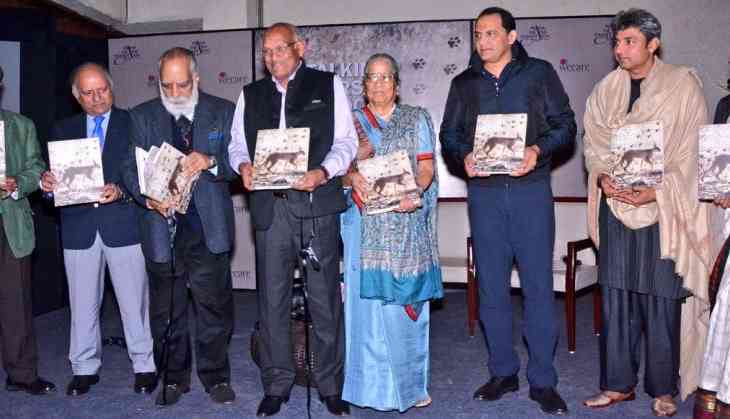Tiger tiger burning bright!

It is raining books on tiger in Rajasthan. As many as three books on tiger authored by tiger enthusiasts from the State were released last week. In fact two of them, the “Silent Sentinels of Ranthambhore” and “Stalking Tigers on Foot” were released in Jaipur on the same day-- December 23. The third one, “My encounters with the big cat” was released at the WWF office in Delhi on December 20.
Rajasthan is one of the Indian states where tiger burns bright though there are other states where the presence of the big cat is in larger numbers. The state has two celebrated tiger reserves, Ranthambhore National Park (RNP) and Sariska Tiger Reserve, which always remain in news. RNP is a favourite destination of both the expert and the enthusiast, as the sighting is perhaps the best in the country here while Sariska, which had lost all its tigers to poaching sometime in 2004-5, is a good case study of tiger relocation.
There are certain interesting aspects about all the three books which would make not only the wildlife enthusiasts but also the general public curious about the tomes. The books are variously written and are by those differently related to the efforts of tiger conservation in the country. The very fact these people ventured into writing too is encouraging considering the challenges before the policy makers and planners in the conservation of these animals and their dwindling habitats.
Take the case of “Silent Sentinels of Ranthambhore”, written by former Rajasthan Minister Bina Kak. During her tenure as the Minister for Forests and Environment in the State in the previous government, Kak got introduced to wildlife photography and could easily claim to possess some of the best ever photographs of the tigers of Ranthambhore. Her book, first released in Mumbai in the second week of December by Salman Khan is not only a visual treat but it also provides an insight into core aspects of tiger conservation and wildlife protection. “I don’t claim to be to be a tiger expert. My book is a minister’s perspective on tiger conservation,” Bina asserts.

“Stalking Tigers on Foot” is a curious case of a one-time hunter Kishan Rungta, turning conservative with the advent of strict wildlife laws in the country during the regime of Indira Gandhi. As his close friends in Jaipur point out, the octogenarian Rungta, who has been a cricket administrator and BCCI selector, stood out among the ones hunted those days as he was the only one from the Vaishaya community to hunt those days—an odd man out among the gun-wielding pack of Kshatriyas of the former Rajputana.
Rungta has a tale—in fact, many tales—to tell as the 200-page narrative unfolds with details of hitherto not widely debated characteristics of the big cat such as cannibalism amongst themselves. While the cannibalism narrative is about the tigers which inhabited Khandar region of Ranthambhore, about which, according to Rungta, the late conservation legend, Kailash Sankhala too was aware of, the ‘man eaters’ he refers to was of Kalidungri near Sariska.
Though the public obsession is with the apex animal tiger, Rungta has not lost the woods for the trees as he talks about a holistic approach to conservation, protecting animal habitats, taking care of the prey base and providing means of livelihood to villages living near the wildlife sanctuaries. The reason that the author chose the picture of the seriously endangered caracal for cover, instead of that of the tiger, too is reflective of his approach to conservation.

The third book under discussion; “My Encounter with Big Cat and other Adventures in Ranthambhore” comes from the grass-root level wildlife manager, Daulat Singh Shaktawat, who retired recently as the Assistant Conservator Forests (ACF) from Rajasthan Forest Department. Perhaps, one can easily term Daulat Singh as an “encounter specialist” with a difference. In his case every time the victim of the encounter was he himself and the attacker, either a wild animal or villagers angry with the wildlife management.
In 2010 the state government headed by Ashok Gehlot had to arrange for a helicopter to bring a seriously injured Daulat Singh to Jaipur after the male tiger T-7 mauled him seemingly out of sheer panic in the Buri Pahari area of Ranthambhore. Daulat Singh had intervened to save the animal which was surrounded by a stone-pelting mob of villagers after it had strayed out of the park into the nearby human habitation.
As mentioned earlier, Daulat Singh has a history of attacks, both by men and wild animals. Back in 1985 during a duty patrol the ACF was attacked by the villagers of Sherpur and Kilchipur in Ranthambhore. As fate would have it, leopards too did not spare him. In 1997 a leopard, under anesthesia, woke up slowly before the stipulated time and sprang on him injuring him badly.
Why of late, so many books on wildlife and tiger? Are they getting popular? “Wildlife books are not hot favourites of book readers. They are mostly pictorial and tend to be expensive as printing costs get prohibitive. And for the same reason they are not sold much,” says Rajpal Singh Tanwar, author, wildlife photographer and long-time member of the Rajasthan Board for Wildlife. “I would term the coming out of these books at the same time as a coincidence. However, it cannot be denied that more people are writing and many more are reading wildlife books these days and that is a welcome development,” he adds.
Books are not like Hindi movies for which the releasing dates are to be watched closely so that they don’t clash causing financial losses. Three books on tiger coming out in succession may only whet the appetite on tiger further and do not cause any glut on the subject in the market. This is more so when each of the author had a separate reason to deal with the matter.
First published: 27 December 2017, 18:39 IST


